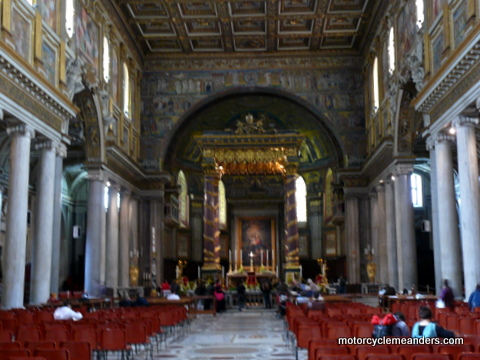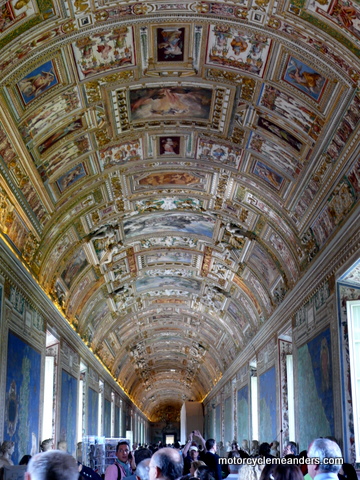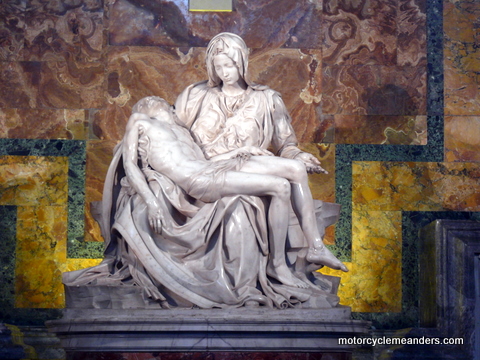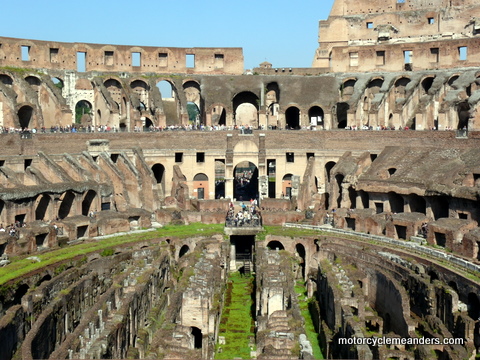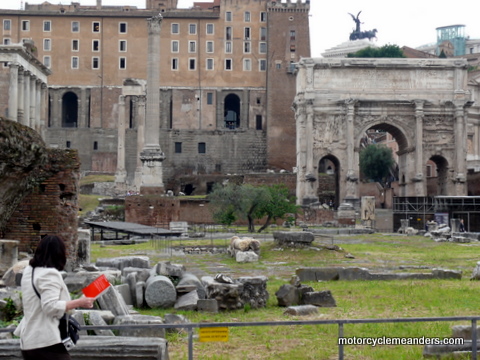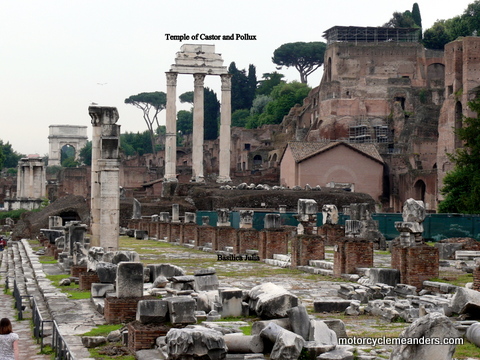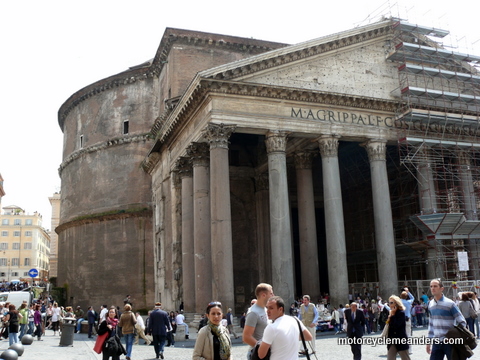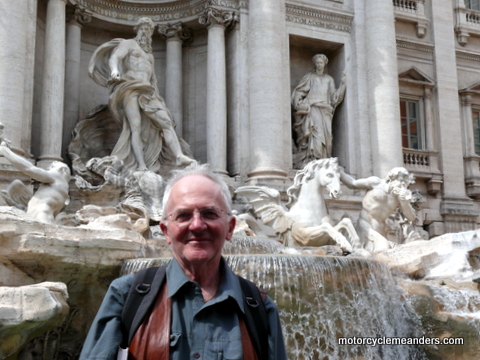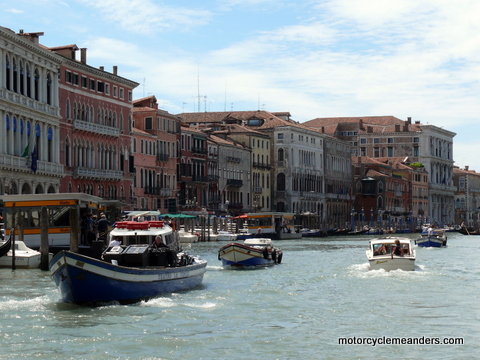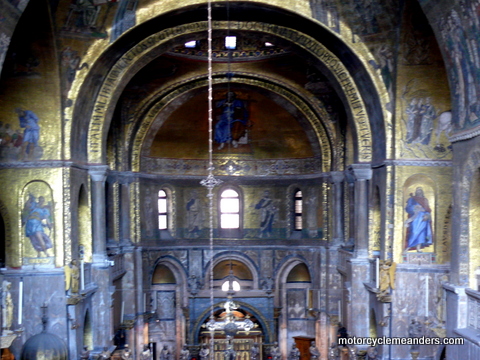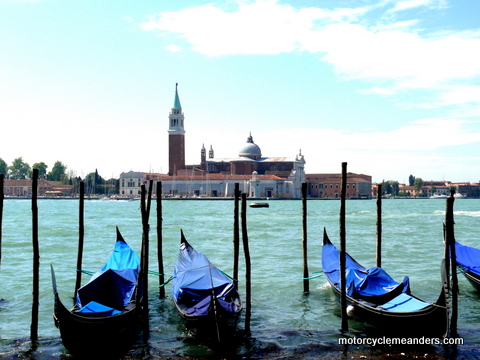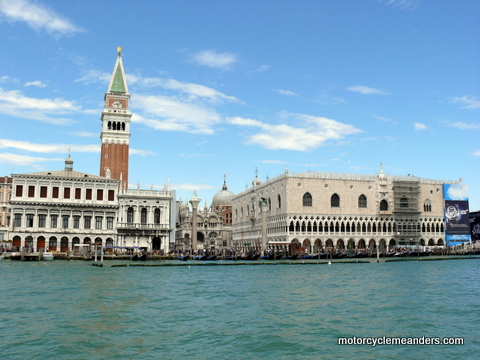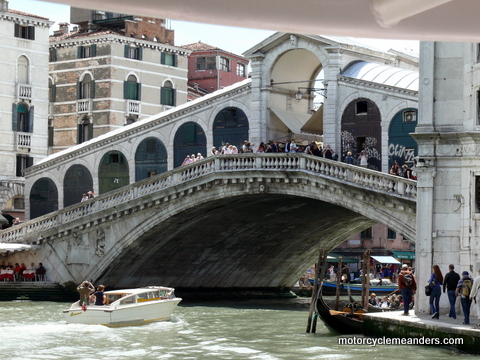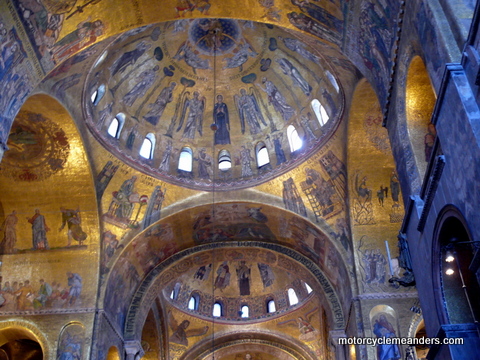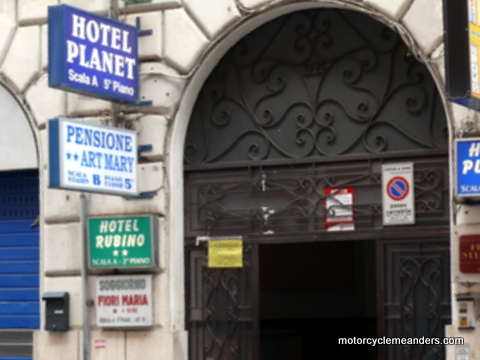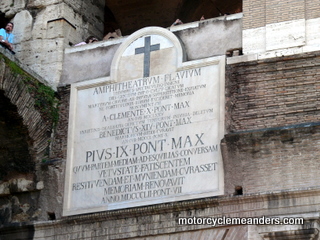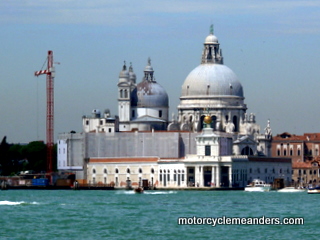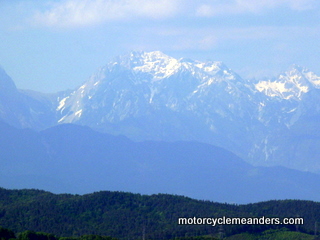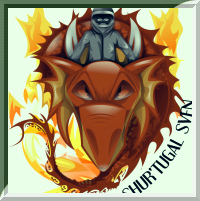
 |
|
Rome and Venice May 2010
Prelude Visits to Rome and Venice preceded my Dalmatia motorcycle meander abroad. I’d never been to Italy before, despite Rome, in particular, being a long-standing focus of aspects of my life – both classical and ecclesiastical. Rome, therefore, was a must-experience destination. Venice fell into place as the second choice, partly because of its unique attraction and partly because it was the obvious and easiest stepping stone to Ljubljana, Slovenia, from where the motorcycle tour would start. Having done many years of Latin and Ancient Greek, inevitably delving into the ancient history, literature and philosophy that centred for centuries on Athens and Rome, the classical side of Rome has always held a fascination for me. To complement that, my many additional years engrossed in matters ecclesiastical, with their rock foundations in Rome, made Rome a special place, even though now it’s mostly academic. Rome
It’s just as well I’m not superstitious...or paranoid. My first day didn’t go quite as planned. Long delays in getting off the plane in Rome, getting into the centre, finding my hotel and checking in meant I’d lost several hours that had been otherwise mapped out for my first foray in classical Rome. The weather didn’t help; and neither did the strains in my foot, injured during my Old Mail Routes trip and aggravated on the Endeavour Voyage, that seemed to have been further aggravated by many kilometres of airport and railway station walking. Fortunately, one of Rome’s great basilicas, Santa Maria Maggiore, was in the near neighbourhood of my hotel, so I settled on a visit there for the day’s sight-seeing. Amongst its claims is the “most successful blend of different architectural styles,” each of which has contributed significantly to the contrasting and complementing components of its structure and decoration. Its impressive gilded ceiling of the 12th century is said to have been constructed from gold first brought by Columbus from America. It’s said to have been founded in 356AD, making it one of the earliest churches in Christian Rome. Christian Rome
The first task was to master the local transport. The Metro is usually the easiest, but, as always – like putting up a tent – the first time always seems complicated. The goal was the Vatican Museums. A reasonably early start was designed to beat the crowds, but an hour twenty-minute queue awaited, constantly badgered by touts for guided tours “with no queue” and a variety of hawkers with everything from souvenirs to umbrellas. The wait, however, was rewarding. The Vatican Museums consist of a network of buildings, rooms, galleries, chapels and the Vatican library (of old). Every aspect constitutes a treasure in its own right. Many of the floors, barely visible under the mass of tourists, are intricate mosaics from ancient Roman temples or buildings. Walls and ceilings throughout are highly decorated, many by huge frescoes (painted on the plaster walls while still wet) and paintings from a succession of great art schools and famous artists such as Rafael and, of course, Michelangelo. These often depict momentous historical, theological or biblical events. The Sistine Chapel is undoubtedly the centrepiece, with its ceiling and wall frescoes of the creation and last judgement.
The day came a little unstuck after three hours in the museums. A ham and cheese roll wasn’t what it looked like. I started to suspect that half way through and dropped the rest in the bin.
The interior of the Basilica is, as I expected, breath-taking. I was instantly reminded of a conversation I had had on the queue for the museums. I happened to be behind a Victorian couple who had just visited “a very impressive church around the corner”. I gleaned they were talking about St Pater’s Basilica. They were certainly impressed. In fact, they were insistent that it was even more impressive than the Catholic Church in Bairnsdale (Victoria), which was their sole point of reference. The interior includes Michelangelo’s Pieta, secured behind armoured glass to protect it from odd-balls, like the Australian citizen that took to it with a hammer some years ago. Pilgrims and other devotees file past a statue of St Peter and rub their hands over his shoes, although I was unsure what their expectations were. People stand in awe at the overwhelming statue of Pope St Gregory (of Gregorian calendar fame). Marble of intricately woven colours and gilded embroidery confront you in every direction, but do so with a refinement and calmness that enhance the experience of being at the very heart of Christianity. I succumbed to a taxi for transport home and was in bed by 5.30pm! Classical Rome
The Colosseum was magnificent. We’ve all seen our fill of photos shot professionally from helicopters or other vantage points or with maxi-pan lenses; but to wander through its corridors, climb its steps, appreciate its grandeur and efficient people-moving design, be amazed at the depth and complexity of the structures that operated under the wooden floor (yes, the floor was wooden, covered in sand (Latin for which is arena), and understand both the happenings there and the social structures that dictated seating were revelations of the ingenuity, sophistication and barbarism of ancient Rome.
I quit the Forum queue and all but dragged myself to the Metro and home. It was such a relief to get to the hotel, with a few bottles of fizzy mineral water I bought along the way. I was in bed by 12.30pm and stayed there until next morning. No more happy bucket scenarios – just beat! After 18 hours in bed I was anxious to test the floor. It was fine. I had a lot of time to make up and a ticket to Venice to purchase for the next day. So it was an early start.
The Roman Forum was the heart of ancient Rome – the ‘down town’ part of the city. That’s where everything happened. It spread out from the Colosseum, at one end of it, like a slowly spreading oil slick on water. Along one side was the Palatine Hill – where the nobles of Rome had their mansions; a trend continued into the middle ages. Along the other side – but now across a main thoroughfare – was another of Rome’s famous seven hills. While the seven hills have great significance for the origins and founding of Rome, I wasn’t tempted to trace or visit them. The forum itself is a mixed bag when it comes to structures – some standing, some displaying the design and size of their former glory, others little more than foundations or less. The Curia, the ancient meeting place of the Roman Senate is there, but it’s a 3rd century re-building greatly restored in 1937. It was first built by Julius Caesar, who made sweeping changes to the lay-out and structures of the Forum as he amassed popularity and influence. Unfortunately, he never got to sit in it as a senator, having been declared ‘too ambitious’ by his fellow senators and disposed of. In fact, it’s only been relatively recently that excavations a couple of kilometres away have unearthed the remains of four republican-era temples and the remnants of the brick steps of the baths of Pompey where Caesar was assassinated on the Ides of March in 44BC. “Beware the Ides of March!”
Back to the Forum. There are the ruins of the rostra (the platform used for public oratory), which Caesar had only recently reorganised and from which Marc Anthony gave his rousing speech of “Friends, Romans, Countrymen” (although he would have said it in Latin – the Shakespeare version, being only a translation). Nearby, there’s the place, which became a shrine, where Caesar’s body was burned. The whole sorry saga, of course, brought the republican era to an end, signalled the demise of the Senate and ushered in the imperial era. I imagine the senators wished they had sought out a more conciliatory option, involving, perhaps, more negotiation rather than only consultation! From the Forum, it was a short walk to the Capitoline Museums, consisting of two buildings – one from the Middle Ages used as the seat of the city magistrates; the other designed by Michelangelo, who renovated the complex of three buildings, which have become Rome’s premier museum for antiquities and other secular treasures, inevitably including religiously themed paintings. Every ‘next destination’ seemed close enough to walk, but by the day’s end I felt I had walked half way around Rome. The Pantheon was a must-see. It started life as a massive Roman temple to all the gods and has become a church. The height of its huge rotunda is equal to its diameter (43m). A hole at the top – the oculus – provides the only light (and lets in the rain). The design and structure of the dome are considered architectural wonders. The Pantheon is often seen as a symbol of Rome itself.
Then the Trevi Fountain. I couldn’t let that slip by. I even threw some coins into it. But I couldn’t remember whether throwing coins into it meant you would fall in love again or return to Rome. I knew it was one or the other. So I took a punt. Then I couldn’t recall which way I bet! But I did remember to throw three coins in the fountain. However, they totalled only 50 Eurocents, so, I guess, either way, I’ll get only what I paid for! I also stopped by several churches highlighted in the guide books as significant examples of art and architecture. They all lived up to their descriptions and worth visits. Walking so much also brought me to several sights that I had resigned myself to missing because of lost time, such as the Spanish Steps and the column of Marcus Aurelius. So I got a few ‘extras’ in there.
Photo Album Here is a photo album of my days in Rome
I had booked on the 8.45am train to Venice. The station was only a three-minute walk with luggage, so timing wasn’t an issue. Like all European train travel, the journey was fast, smooth, comfortable and restful. If only the powers that be in Australia could commit to the VFT concept! Canals for Roads
I had more or less planned to take a canal tour as part of the stay, but here I was, on arrival, travelling the full length of the Grand Canal – from the western end, where Santa Lucia Railway Station is situated, to beyond the mouth of the canal into the St Mark Basin. There were no obvious gaps where the building that sunk in the James Bond movie Casino Royale had been. They must have replaced it already. It was a short haul from the boat stop to the hotel – and what a gem of a hotel! But more about that later.
St Mark’s is a colossal building of five huge domes, with the central dome being significantly larger than the other four. What’s unique about St Mark’s is that the walls and the insides of all the domes are intricate – mostly gilded – mosaic designs. The mosaics glitter in the light, enhancing the images for which the gold becomes the setting and background. It’s mesmerising. The Basilica has its other treasures as well – mostly war booty from the plundering and looting of the old Venetian Republic (the so-called Most Serene Republic; but not beyond a bit of self-enrichment at the expense of the vanquished). Venice agreed to finance the fourth crusade, which, as it turned out, ended up sacking Constantinople on its way to nowhere, opening the door for Venice to reap a generous interest on its investment. Hence, the fabled four gilded bronze horses, so synonymous with St Mark’s, but stolen from the Constantinople hippodrome – not to mention a Treasury full of Byzantine precious prizes that are displayed in the Basilica.
Also towering above Sat Mark’s Square is the Campanile, a tall, minaret-looking, brick structure. It dates to the 12th century and was first built as a lighthouse. It later served as a support for a torture cage where prisoners were often left to die – no doubt in serenity! Galileo first demonstrated his telescope from the top of the tower. Fortunately, there’s a lift these days to take you to the top to enjoy a 360° panorama of Venice, the sea and the mainland. As a final observation, I hadn’t appreciated the extent to which Venice is separated from the mainland. It’s quite a distinct island in a large body of water (described as a swampy lagoon), which, in turn, is partly protected from the open sea (the Adriatic) by strips of land – but not enough to prevent serious flooding at times. Only in more modern times has Venice been linked to the mainland by a rail and road causeway. I was lucky in the timing of my visit to St Mark’s. The crowds were not so bad. However, a second visit was aborted as crowds swelled from the arrival of a monstrous cruise liner that was disgorging some 2000 passengers into the city centre. Doge’s Palace
During the 1000 years or so of the Venetian Republic, the role of Doge (rhymes with doze but the g is more a zh) was invented. The Doge was the supreme ruler of the city-state, voted in via a complicated process involving all the power-brokers of the Republic. Then the displays tell you he had no executive, legislative or judicial powers. In fact, he couldn’t do a lot without being watched and having his hand held by various bodies, all jostling for the ‘front seats’. But he lived royally. The extensive palace served as his residence as well as housing the various chambers the city-state had established for ruling, judging, manipulating and terrorising. The palace today openly parades the functions of its numerous chambers from the small, secretive niches, where people’s fates were settled on any fanciful basis, to the grandiose committee and senate meeting rooms, where wealth and power ruled and governed. Everywhere was decorated with ostentation and lavishness or with subdued rigour as might befit the role and function of the chamber and its constituency. Works of art featured throughout. And there were the several storeys of dungeons, no doubt where hapless souls summoned to one chamber of another were summarily dispatched. In fact, the dungeons were across a canal in another building, but reached directly from the palace via the Bridge of Sighs, named from the lamentations of the prisoners being taken across it. Rialto Emerging back into St Mark’s Square, I headed on foot for the Rialto Quarter, noted not only for its fabled bridge over the Grand Canal but also as the commercial heart of the old republic where merchants sold goods from all over the Venetian ‘empire’ and where most of the local markets were held. It’s a particularly old quarter of an old city. Once across the Rialto Bridge, the return journey becomes a long walk around the outside of a sweeping bend in the Grand Canal to reach the next bridge. Along the way was the Accademia Gallery housing the largest collection of Venetian art. That kept me occupied for a fair time. It was a labyrinthine trek to get back to my starting point. The narrow alleys include many a cul de sac and, without close attention to the map, you end up back-tracking more than need be. It was a full and tiring day, completed by Lobster Taglietelle and a crisp Italian Chardonnay – with some pleasant company on an adjacent table in a Scottish couple from the cruise ship. And a couple of nightcaps at a bar near my hotel. Rialto
Once across the Rialto Bridge, the return journey becomes a long walk around the outside of a sweeping bend in the Grand Canal to reach the next bridge. Along the way was the Accademia Gallery housing the largest collection of Venetian art. That kept me occupied for a fair time. It was a labyrinthine trek to get back to my starting point. The narrow alleys include many a cul de sac and, without close attention to the map, you end up back-tracking more than need be. It was a full and tiring day, completed by Lobster Taglietelle and a crisp Italian Chardonnay – with some pleasant company on an adjacent table in a Scottish couple from the cruise ship. And a couple of nightcaps at a bar near my hotel.
Venetian Finale
By the time I got back to St Mark’s Square just after midday the cruise passengers had rushed off for their 1.00pm departure and the queue into St Mark’s was invitingly shorter. I got to the top of the queue and into the Basilica to enjoy about ten minutes of the full interior lights on the golden mosaics. I recalled reading about the lights being on for only an hour each day (11.30am-12.30pm) but had not remembered that on my first visit. I had simply assumed the natural light experienced at that time was all you got. So it was a great treat to discover the full interior lighting on my second visit. The gilded mosaics absolutely sparkled. I sat out the 10 minutes barely conscious of people shuffling by and gratefully undisturbed from my retreat beyond the condoned-off area. Photo Album
A Few Random Things –
The hotel in Rome was close to the main station – Termini – so I set out on foot to find it, having come in from the airport by train. I found the street all right. It was only a short block from the Termini entrance. But it took some help to find the hotel. I was looking for a ‘regular’ hotel, i.e. a hotel-looking entrance and a foyer of some sort. What I eventually found was a very unassuming entrance to a block of apartments. And it was no swanky entrance, as you might imagine in a river-side apartment block in Melbourne! It was a large, stone-floored, cavernous entry with nothing but a single, caged lift half-way along. There were a few ‘hotels’ inside – on different floors, all simply a few apartments combined. Mine was on the fifth floor. It seemed to consist of three of the four apartments coming off the landing. The ‘foyer’ was just inside one of the doors and was about as big as an average entry hall of a three-bedroom house. The continental breakfast, part of the deal, consisted of taking a voucher across the road to a small cafe and collecting a croissant in a paper napkin and a cappuccino, which, if you were lucky, you could eat sitting at a bench; otherwise you stood around like many others. (A cappuccino in Italy is essentially a flat white in our terms, with a little froth on top – about as much as you might get from one of the designer tops gone wrong we often get on flat whites.) It all certainly exuded dodgy on first encounter; but it all worked. The neighbourhood seemed a mix of levels: lots of immigrants, a few students and some suited folk. The Termini location was perfect for easy access to any direction of sights. I almost messed up in Venice by aiming for an area that I had thought was the main station. It was also the place where I would catch the bus to Ljubljana. Fortunately, I double checked just before committing. That was when I discovered Venice was such an island half way across the bay. I had an instant image of James Bond and Vesper racing around St Mark’s and decided that’s where I needed to be. To my pleasant surprise, I ended up with a very recently renovated hotel in a pretty fancy little street just metres from the St Mark Basin. The hotel is undoubtedly compact. You needed to be somewhat contortionist to manage the bathroom, including the shower; but it’s all new, extremely pleasant and quite delightful.
There’s no shortage of tourists. I had thought that May might be way ahead of the tourist rush; and it might be. But if it is, I’d hate to be sight-seeing and queuing in July or August. I suppose it was really only the Vatican Museums and St Peter’s where waits were over the hour. Most other places were pretty straight-forward, although when I returned to St Mark’s on day 2 for another visit, I was confronted by a queue at least four times the length of the previous day because of the cruise ship’s arrival.
There are a lot of Indian tourists – mostly families travelling by themselves: Mum, Dad and two or three kids, sometimes with grandparents or other extended family. I was sitting on the steps of the Trevi Fountain, when a boy of about 13 next to me caught my attention. “Are you a Roman?” he asked boldly. I felt almost guilty in having to disappoint him, “No, I’m Australian.” “I am Indian,” was the rapid and proud response. “Oh, where do you live?” “Kolkata.” “You speak English very well.” “Yes, I learn it at school. And so we went on to the bemusement or amusement of his parents and big sister. I think it might have been more to her embarrassment.
Venice to Ljubljana The 23rd of May 2010 had been a date in the front of my mind for some months. That would be the day I ventured into a whole new world – places I had never visited and never really contemplated visiting until a year ago when the Dalmatia tour started to take shape.
Slovenia had never been a comfortable fit in the old Yugoslavia, although you might say that about most of its former component parts. Its culture and history had been closer to Austria, so it would feel that it had regained its heritage by being part of the European Union rather than the old Soviet bloc. Getting here had its moments. First, I encountered a boat stoppage in Venice for a period. However, I had allowed myself ample time so it wasn’t a problem. It was fortunate that I chose to wait the 35 minutes in the queue until the first boat, as the queue kept growing over the 35 minutes and only a few of us at the top of the queue managed to get on. That got me to the bus station on the tip of the island at the causeway. Then a bus into Venice’s other station, Mestre (on the mainland) from where I would catch my Ljubljana ‘bus’ (more a people mover).
With about ten minutes to departure time, I resorted to flagging down cars. Nobody was stopping. I had one prospect as a captive at the closed railway crossing but he wasn’t obliging. Then a 4x4 stopped. Once he discovered I was Australian, he couldn’t have been more helpful. He tried a few routes towards Mestre to see if there was a way around the road blocks. Finally, having got as close as he could, he talked his way through a police block with much gesturing and obviously emotional references to my sorry plight. It worked. He delivered me right to the station at 11.30am – right on scheduled departure time. Not that anything was leaving for a while. I had to walk only twenty metres to spot the greatly relieving scene of the small people mover with the insignia DRD on the side, the tell-tale sign that this was my ‘bus’. Then, almost as a consolation for my stress, the Tour of Italy peloton came seeping down the street and around the corner where I was admiring the DRD bus. Its passing took only a fraction of the time it took for the following entourage to pass by. At least, I can add seeing the Tour of Italy to my souvenirs. Thanks to my Italian 4x4 enthusiast, whose name I didn’t even get. There would have been no way of making the bus without his help. I hope he might read this and send me an email.
|
